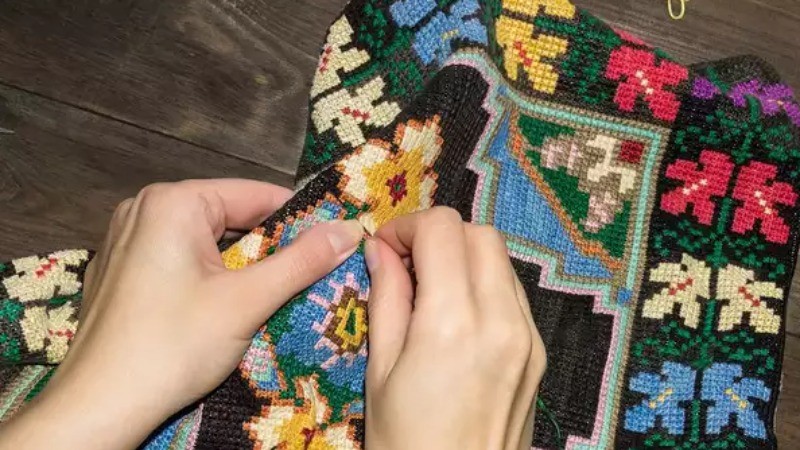
The delicate embroideries of India have a history to behold, that tells the centuries old stories of varied artistry and craftsmanship depicting the rich and diverse cultures of India. Some of these are the rarest of the rare, having lost their significance and are hidden somewhere in the weaving looms or in the corners of the subcontinent.
As we come to an end to the National Embroidery month, it is time that we recognize the talent of the craftsmen who create and art through a thread and needle in hand. Let us take you to an embroidery journey from the North to the South of India, exploring some of the rare and the most traditional embroideries of India:
Crewel Embroidery (Kashmir)
The Crewel embroidery has been in existence since the 11th century, being an indigenous craft of Kashmir. The art form in its prime was once admired by the Mughal Emperors as well as the Queen Elizabeth of England. Crewelwork is a kind of free surface embroidery crafted on wool, with no particular style of patterns. Earlier, the embroidery was done on linen twill, but now silk, cotton velvet, silk organza are also used. Now the embroidery is done on cushions, curtains and other home décor items.
Chamba Rumal Embroidery (Himachal Pradesh)
The royal women of the Chamba region of Himachal Pradesh flourished this traditional embroidery since the 17th century in princely hill states. It has a distinct style with small rectangles and squares, embroidered with silk threads, thin metal wires or metallic yarn identical on both the sides. It was mostly used in wedding gifts and ceremonial coverings, especially brides’ dowry. The embroidery often depicted gods and goddesses in its patterns drawn by women and children, later skilled craftsmen. The Chamba embroidery has lost its significance, sacredness and essence, with families keeping the art alive only fir survival.
Shamilami Embroidery (Manipur)
Shalimali is basically a blend of weaving and embroidery featuring animal designs. It was once considered to be a symbol of high class, that people wore for their recognition of bravery and heroism by the King. The embroidery was adorned on a three paneled traditional shawl for the warriors with some bold tribal motifs that were incorporated as a belief to offer protection in a battle. Similar versions can be observed in Nagaland as well.
Khneng Embroidery (Meghalaya)
Khneng (meaning border) is a 200-year-old Khasi embroidery that belongs to Mustoh village of Meghalaya. The Khasi community practices the craft, with the designs reflecting their belief and connect to nature. It was inspired by a local insect called Kitiar. Mustoh is the only known village practicing Khneng embroidery, deeply rooted in the culture of Khasis. Khneng is traditionally done on eri silk shawls.
Sujini Embroidery (Bihar)
Sujini embroidery originated in the 1920s in the Bhunsura village of Bihar originally as a form of quilting. The simple elegant styles on vibrant shades of silk and cotton are known for the kantha running stitch. The motifs featured include geometric shapes and symbols of nature. Sujini embroidery often depicts storytelling by women, about resilience and overcoming hardships. The craft almost became extinct and was revived in 1988. It is now protected under the GI Act.
Pipli Embroidery (Odisha)
The Pipli embroidery has its origins back to 12th century from the Pipli village of Odisha. Bright patterned fabric pieces are stitched together on a plain cloth, mostly velvet. Mirror and lacework is also done, along with stitching of patterns. Based on the patchwork it began to be known as Chandua. Originally, pipli work began to be done in the Jagannath Puri culture during the Rath Yatra, the designs reflected the same. And nowadays, Pipli embroidery can be found in home décor items.
Rabari Embroidery (Gujarat)
Rabari embroidery is practiced by the nomadic Rabari or Rewari community of Gujarat and Rajasthan. The colorful, vibrant and vivid patterns of Rabari very much reflect upon the women who make it. Traditionally, the designs, motifs and patterns depicted upon the mythological and historical events of the past. Mirrors of all shapes and sizes are also added to the embroidery, for the belief that it will protect from evil spirits.
Gujarat is also home to another traditional embroidery, the Karchobi embroidery which was introduced in the 17th century. It is a type of Mochi embroidery that belongs to the Kutch region. Karchobi embroidery could be observed on bridal outfits, temple chariots and tent hangings.
Kasuti Embroidery (Karnataka)
‘Kasuti’ translates to Kai, meaning hand and suti which is weave or wrap. The embroidery has its origin back to the Chalukya rule from the 6th to 12th century in North Karnataka. In Kasuti embroidery, there is a single thread which involves the counting of each thread on the cloth. Both sides of the cloth look identical, as the stitching of the patterns is without any knots. It was inspired by the local rangoli patterns, with those of a chariot, palanquin, lamps began to be formed through stiches like Gavanti, Murgi, Negi among others.
Toda Embroidery (Tamil Nadu)
The name of the embroidery is derived from the tribe that embroiders it, the Toda or Todu community of Nilgiris. You can witness sacred red and black patterns on shawls called poothkuli. Designs made by them reflect on their ancestors’ tattoos that are believed to guide spirits to the afterlife. Practiced by women, the embroidery has its own unique style called pugur, which means flower. The designs also stylize sun, moon, stars and the eyes of peacock feathers.
The rarest embroidered threads are the most delicate and fragile. In the modern era, the traditional embroideries need to be cherished and appreciated a lot more. Also, it is time to preserve the craft and its craftsmanship for the coming generations, so that the legacy and tradition continues ahead…before they turn into absolute oblivion.